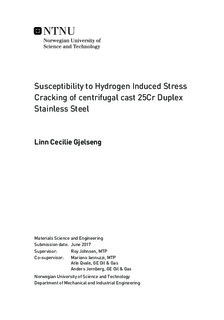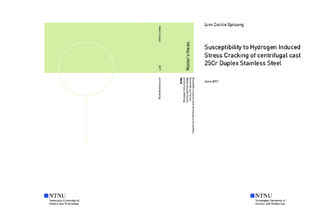| dc.description.abstract | Testing of the susceptibility towards hydrogen induced stress cracking (HISC) for five 25\%Cr super duplex stainless steels (SDSS) under cathodic protection (CP) in seawater has been conducted. The materials were from pipes produced through different production methods; hot extrusion with and without subsequent cold drawing, manufactured from a forged bar and centrifugally cast. The testing was carried out in cortest proof rings on three test specimens pre-charged with hydrogen and one reference specimen without hydrogen until fracture occurred. Hydrogen measurements were conducted and the fracture surfaces were examined in a scanning electron microscope (SEM), and the embrittlement through thickness was indexed. The possibility of secondary cracking was also investigated using the SEM. In addition, the microstructures were examined using optical microscopy (OM) and assessed compared to the HISC testing results. The austenite spacing was also measured.
The hydrogen measurements together with the presence of secondary cracking of all test materials confirmed HISC being the fracture mechanism. The test results indicated that all SDSS materials tested are susceptible to HISC, and that the hot extruded material with no cold deformation has a higher HISC resistance while centrifugally cast materials are more prone to HISC than the other production methods. The fracture surfaces of all hydrogen charged test materials showed features indicating a reduction in ductility due to HISC as well as both ductile and brittle fracture characteristics across the surfaces. The placement of the ductile and brittle features varied, and both could be found close to the centre and edges of the fracture surfaces. The fracture surfaces for the reference specimens showed mostly ductile fracture characteristics.
The results from the HISC testing were discussed compared to available literature on the subject of HISC in SDSS, and the susceptibility of the materials from the different materials towards HISC were ranked from lowest to highest based on the overall test performance and measurements conducted. The ranking of production methods is as follows: hot extruded pipes > hot extruded pipes with subsequent cold drawing > forginged pipes > centrifugal cast pipes. | |

